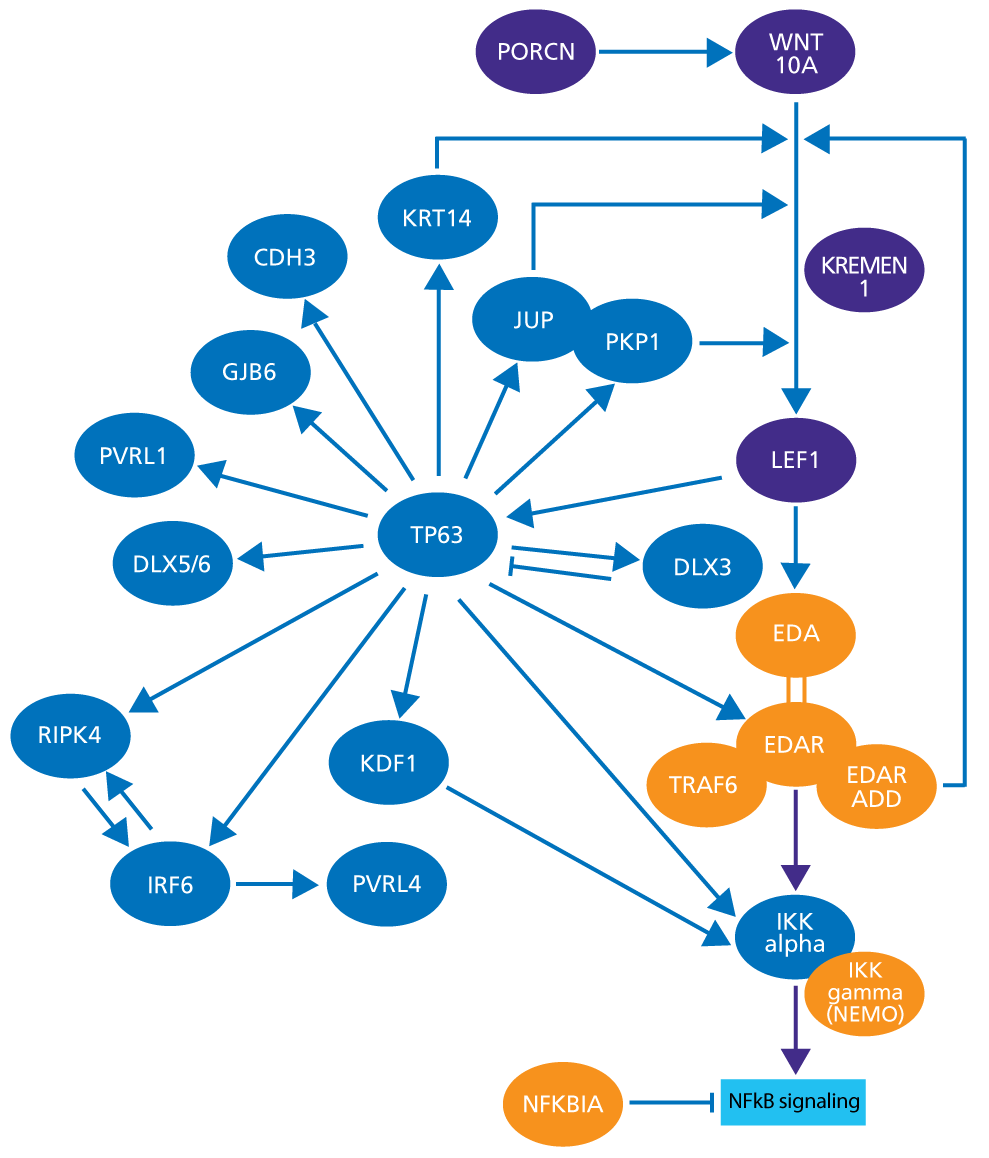Ectodermal dysplasias
Ectodermal dysplasias are genetic conditions characterised by atypical development or function of ectoderm-derived structures such as hair, teeth, nails and sweat glands. At least two systems should be affected to classify as ectodermal dysplasia.
Overview
Ectodermal dysplasia refers to a group of rare genetic conditions affecting ectoderm-derived tissues. It can present at birth or later in life, with symptoms varying by type. Common features include sparse hair, missing or atypical teeth, brittle nails and reduced sweating. These conditions are caused by pathogenic variants in genes involved in ectodermal development and can follow autosomal dominant, autosomal recessive or X-linked inheritance patterns.
Clinical features
Clinical features of ectodermal dysplasias include:
- sparse or absent hair (hypotrichosis);
- missing, malformed or widely spaced teeth;
- brittle, ridged or absent nails;
- reduced or absent sweat glands leading to heat intolerance, including febrile seizures;
- dry skin and mucosal anomalies; and
- facial features such as prominent forehead and/or thin lips.
Genomics
Ectodermal dysplasias are caused by pathogenic variants in genes that are involved in ectodermal development pathways (see figure 1).
The molecular mechanisms can be divided into errors in the nuclear factor kB signalling pathway (for example, EDA, EDAR and EDARADD), the p63 transcription factor pathway, the Wnt-beta-catenin pathway, gap junctions (for example, GJB6), and structural/adhesive molecules (cytokeratins and desmosomal components). These errors disrupt the formation and function of ectoderm-derived tissues.
Genomic testing focuses on identifying pathogenic variants in these genes to confirm diagnosis and guide management.

Figure 1: Outline of genetic interactions that cause ectodermal dysplasia
The multiple interactions between the EDA/NF-κB, Wnt and p63 pathways (in orange, purple, and blue, respectively). Arrows indicate stimulatory protein-protein or protein-gene regulatory interactions, while bars are used for inhibitory interactions.
Image based on Peschel and others, 2022 (see ‘Resources’ section below for full reference).
Diagnosis
Diagnosis is based on:
- clinical evaluation of ectodermal anomalies;
- dental examination for missing or atypical teeth;
- skin biopsy or sweat gland function tests; and
- genomic testing to identify pathogenic variants.
A gene panel test is available for the genes known to cause ectodermal dysplasia. For more information about genomic testing for suspected ectodermal dysplasia, see Patient with sparse hair and peg-shaped teeth.
This condition may be identified before any symptoms appear, for example through the Generation Study. Confirmation of the diagnosis will require referral to your local specialist team, or to Dr Gabriela Petrof at Great Ormond Street Hospital in London or Dr Marie-Louise Lovgren at Birmingham Children’s Hospital. Please refer to the local pathway for your region.
Inheritance and genomic counselling
- Ectodermal dysplasia can follow autosomal dominant, autosomal recessive or X-linked inheritance patterns, with the most common being X-linked recessive. X-linked forms, such as hypohidrotic ectodermal dysplasia, primarily affect males, although female carriers may have an intermediate phenotype. X-linked hypohydrotic ectodermal dysplasia affects about 1 in 5,000 to 10,000 live births globally.
- Genomic counselling is essential to discuss inheritance risks, carrier testing and implications for family members.
Management
- Management of ectodermal dysplasia focuses on symptomatic treatment, such as dental prosthetics, skin care and temperature regulation. Gene therapies are under investigation but are not yet widely available.
- Referral of affected patients to clinical genetics should be considered to discuss onward management, family planning implications and cascade testing of relatives at risk.
- If the condition is identified before any symptoms appear, for example through the Generation Study, management may differ from management of those presenting symptomatically.
Resources
For clinicians
- Genomics England: NHS Genomic Medicine Service (GMS) Signed Off Panels Resource
- NHS England: National Genomic Test Directory
- StatPearls: Ectodermal Dysplasia
References:
- Peschel N, Wright JT, Koster MI and others. ‘Molecular pathway-based classification of ectodermal dysplasias: First five-yearly update‘. Genes 2022: volume 13, issue 12, page 2,327. DOI: 10.3390/genes13122327
For patients
- ED Society
- National Foundation for Ectodermal Dysplasias: Genetics and inheritance